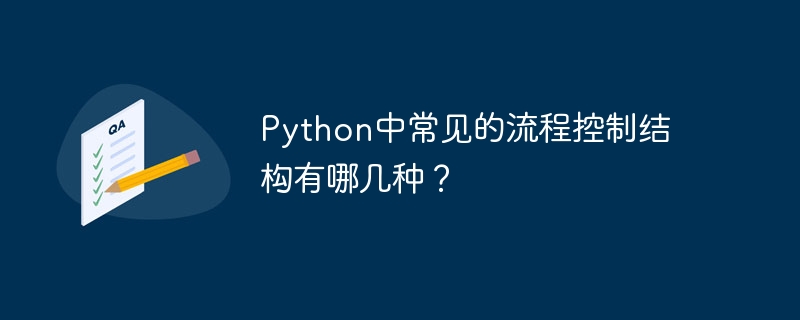Home >Backend Development >Python Tutorial >What are the common flow control structures in Python?
What are the common flow control structures in Python?
- 王林Original
- 2024-01-20 08:17:06590browse

What are the common flow control structures in Python?
In Python, the flow control structure is an important tool used to determine the execution order of the program. They allow us to execute different blocks of code based on different conditions, or to execute a block of code repeatedly. The following will introduce common process control structures in Python and provide corresponding code examples.
-
Conditional statements (if-else):
Conditional statements allow us to execute different code blocks based on different conditions. Its basic syntax is:if 条件1: # 当条件1成立时执行的代码块 elif 条件2: # 当条件2成立时执行的代码块 else: # 当以上条件都不成立时执行的代码块
Sample code:
age = 18 if age >= 18: print("你已经成年了") else: print("你还未成年")Output result:
你已经成年了
- Loop statement:
Loop statement allows us to repeatedly execute a piece of code multiple times until a certain condition is met. There are two common loop statements in Python: for loop and while loop.
2.1 for loop:
The for loop is used to traverse each element in an iterable object (such as a list, string, etc.) and execute the corresponding code block. Its basic syntax is:
for 变量 in 可迭代对象:
# 执行的代码块Sample code:
fruits = ["apple", "banana", "orange"]
for fruit in fruits:
print(fruit)Output result:
apple banana orange
2.2 while loop:
The while loop is used to repeatedly execute a piece of code. until the condition no longer holds true. Its basic syntax is:
while 条件:
# 执行的代码块
# 更新条件,避免无限循环Sample code:
count = 0
while count < 5:
print("Count:", count)
count += 1Output result:
Count: 0 Count: 1 Count: 2 Count: 3 Count: 4
- Jump statement:
Jump statement is used in the code Skip certain codes or break out of loops during execution. Common jump statements in Python include break, continue and return.
3.1 break statement:
The break statement is used to terminate the loop and jump out of the loop body. It can be used anywhere within a loop to terminate the loop early. Sample code:
fruits = ["apple", "banana", "orange"]
for fruit in fruits:
if fruit == "banana":
break
print(fruit)Output result:
apple
3.2 continue statement:
The continue statement is used to terminate the current iteration and jump to the next iteration. It can be used anywhere within a loop to skip certain code. Sample code:
fruits = ["apple", "banana", "orange"]
for fruit in fruits:
if fruit == "banana":
continue
print(fruit)Output result:
apple orange
3.3 return statement:
The return statement is used in functions to return the execution result of the function and end the execution of the function. It can also be used to break out of loops. Sample code:
def sum_numbers(numbers):
total = 0
for number in numbers:
if number == 0:
return total
total += number
numbers = [1, 2, 3, 0, 4, 5]
result = sum_numbers(numbers)
print("Sum:", result)Output result:
Sum: 6
The above are the common process control structures in Python. Through conditional statements, loop statements and jump statements, we can flexibly control the execution flow of the program. , making it more in line with our needs.
The above is the detailed content of What are the common flow control structures in Python?. For more information, please follow other related articles on the PHP Chinese website!

